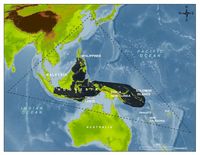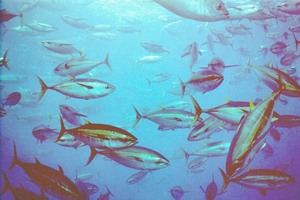by Mallika Naguran
Think twice about eating Atlantic salmon from Norway, it says, but go ahead to enjoy Pacific salmon from Alaska, United States. A handy pocket-sized takeaway seafood guide produced by WWF for the Hongkong market, and soon, Singapore lists marine animals that are safe to eat, under threat and endangered.

Coral fish Juveniles Humphead wrasse, Cheilinus undulatus in Hongkong market. Photo © Michèle DÉPRAZ.
Over consumption of seafood, particular in Asia, is stripping our seas of ecologically crucial fish species and marine biodiversity such as the humphead wrasse, high-finned grouper, leopard coral trout and more. "You can choose to eat the right type of seafood that's sustainably caught," says Dr Lida Pet-Soede, Coral Triangle Network Initiative Leader, WWF.
Public education has made some headway in Hongkong with more than 50 corporations supporting the initiative by ordering only sustainable fish sources for their banquets.
To help push this awareness in a big way in particular Singapore “a travel gateway to the Asia Pacific”, the WWF has launched a Singapore conservation fund starting with the inaugural Asia Panda Ball. WWF’s signature fund-raising event will be brought to Asia for the first time on Friday 21 November 2008 at the St Regis Singapore to be graced by Her Royal Highness Princess Laurentian of the Netherlands. Funds raised will help WWF Singapore kickoff this sustainable live reef fish trade and Coral Triangle eco-tourism awareness.

Where have all the fishes gone? Photo © Jürgen FREUND / WWF-Canon
Both consumers and corporations will learn the importance of maintaining a healthy ecosystem in our coral reefs, in particular the Coral Triangle, an area spanning Malaysia, Indonesia, the Philippines, Papua New Guinea, the Solomon

Coral Triangle © WWF
Islands, Fiji and Northern Australia, over 5.7 million square kilometres. It is home to 75 percent of all coral species known to science and attracts 3,000 fish species, six of the seven species of marine turtles, migrating whale sharks, manta rays and marine mammals including 22 species of dolphins (Source: WWF).
The booklet lists seafood types safe to eat; types to think twice before eating; and varieties to avoid touching it altogether, for gastronomic purposes at least (see below for full listing).
Wish to attend the Asia Panda Ball? Send an email to pandaball@wwfint.org or visit www.wwf.sg.
WWF SEAFOOD GUIDE(Hongkong 2007 Edition)
Recommended (Caught or farmed in an ecologically-friendly way. Fisheries well managed)

Vibrant ecosystems. ©Cat Holloway.
Species Name, Origin
Pacific salmon, Alaska, US
Sardine, Portugal
Leopard coral trout, Australia
Sea urchin, S China Sea
Scallop, China, Australia
Chilean sea bass, S Georgia, UK
Geoduck, N America
Clam, China
Black cod, N America
Squid, Global
Abalone, China, Australia
Rock lobster, W Australia, E Australia
Oyster, China
Think Twice (Some issues with fishing or farming method, fisheries management. Increased demand may affect sustainability.)

Yellowfin tuna. Photo © Ezequiel NAVÍO.
Species, Origin
Atlantic salmon, Norway
Big eye, S China Sea
Silver pomfret, S China Sea
Rockfish, S China Sea
Longfin grouper, S China Sea
Golden threadfin bream, S China Sea
Horsehead, S China Sea
Squid, S China Sea
Star snapper, Hongkong
Areolate grouper, Hongkong
Duskytail grouper, Hongkong
Giant grouper, Hongkong
Three-banded sweetlip, Hongkong
Mangrove snapper, Hongkong
Pompano, Hongkong
Yellowfin seabream, Hongkong
Tiger grouper, SE Asia
Sardine, Thailand
Orange-spotted grouper, Thailand
Turbot, China
Mud crab, China
Yellow croaker, China
Ling, New Zealand
Yellowfin tuna, Global
Avoid (Over exploited, caught or farmed in an ecologically unfriendly way and fisheries not well managed)
Species, Origin

Humphead wrasse. © John E. RANDALL.
Bombay duck, S China Sea
Hairtail, S China Sea
Flathead, S China Sea
Unicorn leather jacket, S China Sea
Red crab, S China Sea
Shrimp, S China Sea, China
Horseshoe crab, S China Sea
Cuttlefish, S China Sea
King mackerel, S China Sea
Mantis shrimp, S China Sea
High-finned grouper, SE Asia
Squaretail coral trout, SE Asia
Camouflage grouper, SE Asia
Leopard coral trout, SE Asia
Humphead wrasse, SE Asia
Orange roughy, Global
Chilean sea bass, Global
Swordfish, Global
Bluefin tuna, Global
Caviar (Sturgeon), Global
Hongkong grouper, China
Abalone, S Africa
And of course, sharks. WWF explains that shark fisheries are unregulated and many populations overfished. As shark species are difficult to distinguish, it is best to avoid all shark products.
Photos by WWF.
Related articles in Gaia Discovery:
Dr Lida Pet-Soede on inventive conservation methods used by WWF.
Why biodiversity and ecosystems are important.